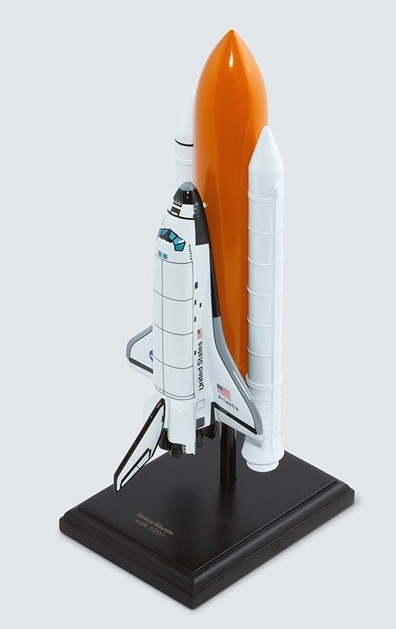NASA - Space Shuttle Atlantis with Full Stack - 1/200 Scale Plastic Model |
|
Painstakingly detailed and fully assembled, this model includes a stand for desktop or shelf display. This high quality replica is handcrafted from plastic and comes with a wooden display base. |
| NASA Space Shuttle Atlantis (OV-104) Atlantis, the fourth orbiter to become operational at Kennedy Space Center, was named after the primary research vessel for the Woods Hole Oceanographic Institute in Massachusetts from 1930 to 1966. The two-masted, 460-ton ketch was the first U.S. vessel to be used for oceanographic research. Such research was considered to be one of the last bastions of the sailing vessel as stream-and-diesel-powered vessels dominated the waterways. The steel-hulled ocean research ship was approximately 140 feet long and 29 feet wide to add to her stability. She featured a crew of 17 and room for five scientists. The research personnel worked in two onboard laboratories, examining water samples and marine life brought to the surface by two large winches from thousands of feet below the surface. The water samples taken at different depths varied in temperature, providing clues to the flow of ocean currents. The crew also used the first electronic sounding devices to map the ocean floor. The spaceship Atlantis has carried on the spirit of the sailing vessel with several important voyages of its own, including the Galileo planetary explorer mission in 1989 and the deployment of the Arthur Holley Compton Gamma Ray Observatory in 1991. Atlantis is commonly referred to as OV-104, for Orbiter Vehicle-104. Empty Weight: 151,315 lbs at rollout and 171,000 lbs with main engines installed. Atlantis benefited from lessons learned in the construction and testing of Enterprise, Columbia and Challenger. At rollout, its weight was some 6,974 pounds less than Columbia. The Experience gained during the Orbiter assembly process also enabled Atlantis to be completed with a 49.5 percent reduction in man hours (compared to Columbia). Much of this decrease can be attributed to the greater use of thermal protection blankets on the upper orbiter body instead of tiles. During the construction of Discovery and Atlantis, NASA opted to have the various contractors manufacture a set of 'structural spares' to facilitate the repair of an Orbiter if one was damaged during an accident. This contract was valued at $389 million and consisted of a spare aft-fuselage, mid-fuselage, forward fuselage halves, vertical tail and rudder, wings, elevons and a body flap. These spares were later assembled into the orbiter Endeavour. Atlantis was shipped to California to undergo upgrades and modifications. These modifications include a drag chute, new plumbing lines that configure the orbiter for extended duration, more than 800 new heat protection tiles and blankets and new insulation for the main landing gear doors, structural modifications to the Atlantis airframe. Altogether, 165 modifications were made to Atlantis over the 20 months it spent in Palmdale, California. |

